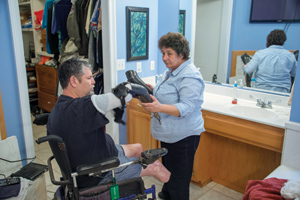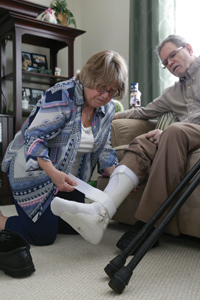
The VA MISSION Act promised expanded caregiver benefits, but pre-9/11 veterans are still waiting
October was supposed to signify the long-anticipated start of the first-wave enrollment for pre-9/11 veteran caregivers into the Department of Veterans Affairs’ comprehensive caregiver support program. But continued delays certifying the VA’s information technology solution for the program have pushed back the timeline for expansion.
Now those veterans—some who have already been waiting for decades—must wait even longer without the comprehensive support services they need.
DAV stood behind passage of the VA MISSION Act last year, largely in support of its provisions to expand the VA’s caregiver program to veterans severely injured prior to Sept. 11, 2001—something the organization has long battled to bring to fruition. The unending setbacks, however, are making some veterans feel as though they simply aren’t a priority for the VA.
“It’s like they’re playing cat and mouse with us, and they’re holding things up when they really need to be addressing the needs of caregivers,” said Past National Commander Ray Dempsey, who suffered a spinal cord injury while serving in Vietnam and has relied on the help of his wife and caregiver, Pat, for daily living assistance for decades.
“My time away is getting less and less,” said Pat. “I go to the store for an hour and come home and he’s on the floor because he’s slipped off his wheelchair. A little bit of respite would be very helpful.”

The IT system currently in place for the caregiver program—which manages applications, administers support services, processes payments and tracks calls to the caregiver support line—is facilitating roughly 20,000 caregivers. It was only designed to accommodate around 5,000.
This is the VA’s fourth attempt to revamp the caregiver program’s IT system since the Government Accountability Office first issued a report detailing issues in 2014, having started—and abandoned—a previous IT solution after spending more than three years in development.
Several years and several million dollars later, veterans and their caregivers are still waiting for help.
“It’s unacceptable and extremely disappointing that this effort has been so mismanaged, considering how much time has passed since the 2014 GAO report and all of VA’s assurances since,” said Deputy National Legislative Director Adrian Atizado. “Veterans and their caregivers are paying for the VA’s continued delays with their health and well-being. They deserve better than this.”
The VA has outlined a three-phase rollout to implement the new Caregiver Records Management Application (CARMA) IT system. This October, the department will replace the old system’s caregiver tracking capabilities. By January 2020, it is slated to automate stipend processing. And the third phase will deliver functionalities that would allow the VA to certify that CARMA fully supports expansion of the caregiver program to pre-9/11 veterans and caregivers.
As of yet, though, there is no contract or delivery date for the third phase of the rollout.
“We feel like we’re getting pushed to the back,” said Pat Dempsey. “Caregiving is 24/7; it doesn’t get easier. It’s getting difficult for us to see the light at the end of the tunnel. The hope just isn’t there.”
At the May hearing, House Veterans’ Affairs Committee ranking member Phil Roe noted one of the most stark realities of the situation: “This is affecting a generation that is dying at hundreds per day.”
With each passing day, fewer and fewer veterans will be able to access the benefits they earned.
“It’s well past time to end the delays and correct the course of the program,” said Atizado. “The VA can’t be in the business of offering empty promises to veterans and their families. It’s time they make good on delivering these critical benefits.”